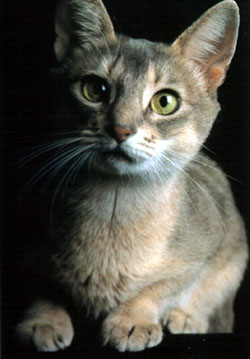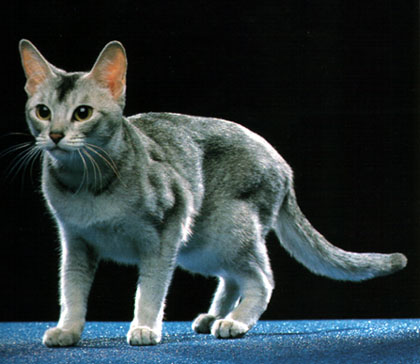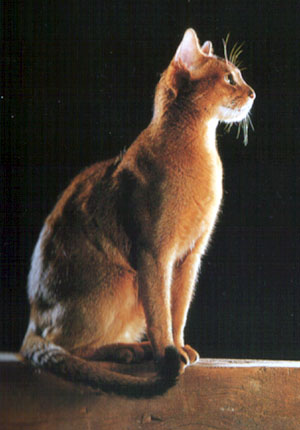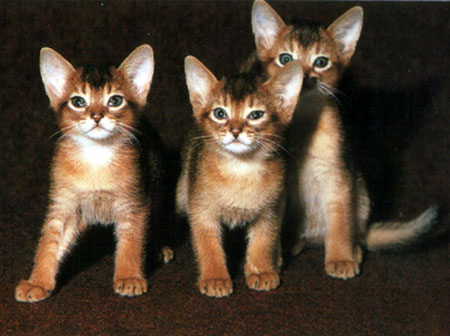Abyssinian
There is a well known story told about an English woman who longed to possess a pure breed Abyssinian. Mrs. Forbes, just after the First World War, actually journeyed to Ethiophia and travelled through the country in peril of life and limb, looking for the perfect specimen - which of course she did not find as the Abyssinian is an English breed, which was introduced in London in 1868!
In fact, this little feline, often described as the archetypal cat, is of African descent. A British diplomat, posted to Addis Abbaba, fell in love with one of his Ethiophian friend's cats. The animal possessed a very interesting coat, the hairs of which were thicked, rather like those of a hare.
Whe the diplomat was recalled to London he was able to bring the cat back with him and it proved so popular that he determined to try and reproduce it. After a number of failures he finaly succeeded in breeding a litter of kittens with thick coats. Breeders of Abyssinians had to fight for years to get the breeds recognised. It was only in 1929 that the Governing Council of the Cat Fancy decided to admit the Abyssinian to the holiest of holies.
Since then the Abyssinian has held a place in the first rank of feline aristocracy. It has become one of the great breeds and is more and more sought after, in both Erope and North America. Its popularity is due not only to its physical appearance but equally to its intellectual and spiritual qualities.
Both in repose and movement, the Abyssinian is always supremely elegant. No other cat can so successfully adopt a hieratical pose. It reminds us of the ancient Egyptian Cat gods, seen on temple columns. The Abyssinian also makes it easy to understand why the Egyptian revered Bastet, the cat-headed goddes.
The sight of this cat moving in perfect harmony, the muscles rippling under its skin, with its great expressive eyes, long, pricked up ears and inner air of nobility, makes one see why people fall in love with this perfect animal.
Very clean, an excellent climber and of unequalled robustness, the Abyssinian needs excercise. But it will get used to living in an apartment as long as it is free to move about from one room to another. A terrace or courtyard garden is sufficient for the cat to stretch its legs if necessary. Not inclined to wander, it will not want to go much further.
A proud cat, aware of its strength, the Abyssinian also knows when to give in; it is a one person cat and will give its owner exclusive devotion and obedience. But with other people the Abyssinian knows what is due to its pride. If you tease it or try too hard to get a response it will quietly withdraw. The claws only ever come out as a last resort.
The Abyssinian will eat most things, but starchy foods ar fatty meats should be excluded from its diet. A mixture of fresh and tinned food should be fed. Grooming poses no problems. A brush over every 2 or 3 days is sufficient. When moulting, a good brushing against the lie of the hair is beneficial.
Breeders produce Abyssinians of various colors. The most popular is a reddish brown. Standards vary and the following is for the normal ticked, ruddy brown Abyssinian.
GENERAL
Medium sized, long and slender body. Well muscled supple and extremely well proportioned. Fine, sensitive legs, small feets with black pads. Thick haired tapering tail.
HEAD
Long, delicate and triangular in shape but not exaggeratedly so. The nose is outlined in black. Wide based ears, sometimes with a little tuff of hair at the point, like a lynx. The luminous, almond shaped eyes, outlined in black, are full of expression.
COAT
Soft to the touch, it should have no strong markings such as stripes or patches. The tickings, however must be visible. The fine ticked coat is unique among cats. Each hair has 2 or 3 distinct bands of color, the whole blending into an effect often compared to a Belgian hare. Preferred coloring is reddish brown (known as ruddy in US) ticked with black or dark brown. Insides of the legs and the belly should harmonised with the main color, shades from apricot to dark orange being preferred.
The Red Abyssinian should also have clear ticking, but the color should be a a dark reddish brown throughout, with pink nose and pads.
PICTURES
Information and pictures taken from
'1001 Images of Cats'
1992 Tiger Books International PLC, London
Home | Updates | The Library | F.A.Q | Send Us Your Works | Links




